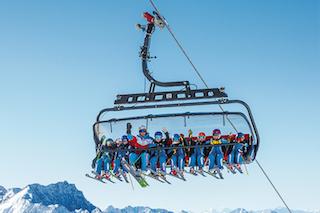
By John Fry
For 35 years, the National Ski Areas Association (NSAA) has reliably measured the volume of winter visits at U.S. areas. The statistic—one skier or snowboarder on the slopes for one day with a lift pass—is not perfectly accurate, but it is the most consistent available to track the trend in participation over the years. Visits reached record highs of over 60 million-plus days in 2008 and 2011. Last season, however, at 53.3 million days, they were down 11 percent from the record highs. Ski area visits are back to the level of 30 years ago in 1987.
Something else may have changed, too. According to the latest NSAA research, frequent skiers and snowboarders—people on lift-served slopes for six or more days a winter—now account for 70 percent of all visits.
Put another way, only 28 percent of 9.2 million skiers and snowboarders account for 70 percent of all ski area visits. Anyone planning to be on the slopes more than six days a winter can be tempted to buy one of the many varied season passes, such as Epic, Ikon, or Mountain Collective, plus a myriad of passes offered by individual ski areas to reward frequent skiers.
Roughly speaking, anyone willing to lay down between five hundred and a thousand dollars before the end of November is enjoying the lowest lift prices, adjusted for inflation, in the sport’s history. For everyone else, there’s a mixed bag of discounted passes throughout the season, too varied and numerous to describe here. Infrequent or casual skiers and snowboarders unfamiliar with how to purchase discounted tickets in advance can be experiencing the highest-ever ticket prices.
Last winter, the average U.S. weekend window lift ticket price was $122.30. That’s 30 times greater than it was a little over half-a-century ago when the 1965 weekend lift ticket sold on average for $4.18. Over the same period of time, U.S. disposable family income multiplied 2.75 times, rising from $14,174 to $39,155. In other words, the window lift ticket price grew 10 times faster than people’s income available to spend in a discretionary manner.
During that time, obviously, the on-slope experience has been substantially improved by resort investments in grooming, snowmaking, faster lifts, new and upgraded day lodges. But an economist who found that the cost of an industry’s product or service over a half-century had increased 10 times more than did disposable family income, would be unlikely to form an optimistic picture of the industry’s future.
Almost all of U.S. family income growth since 2008 has gone to just ten percent of Americans. That may be okay insofar as skiing correlates with higher incomes. But a prime component historically of the skier population, young college graduates, has been negatively impacted by this trend. NSAA notes a decline in visits of young men and women aged 13 to 24, coinciding with a downturn in snowboarding.
College loan indebtedness has doubled in the last ten years. Paying interest on their loans has left men and women in their twenties with less money to spend on recreation.
Of course, cost isn’t the only factor impacting ski area visits. People’s leisure time is being eaten up by social media and computer games. It has affected all outdoor sports. Compared to the decline in tennis and golf, ski participation has done well, merely by declining less.
A CLOUDED FUTURE
The late Jim Spring, who did consumer research in skiing over many years, found a high number of people who call themselves skiers not participating for a season. The most promising way to increase participation numbers, he concluded in 1995, was to convince people to ski every year.
In similar thinking, the McKinsey consulting firm in 1989 concluded that the best prospect for increasing skier numbers lies with light skiers who’ve already made a commitment to the sport. McKinsey reasoned that heavy skiers held little additional potential to expand the market, though they are the easiest for ski areas to reach.
McKinsey didn’t highlight cost, rather the need to improve the experience. And there’s the problem. Skiing is a sport involving bodily injury risk, discomfort, possible fear of heights. While many ski areas offer attractive learn-to-ski/ride deals, the newcomer must have suitable clothing, stand in lines to buy a ticket and rent equipment, and pay a ski school to learn how to slide down a hill without risking a fall or collision. According to research conducted by NSAA, more than four out of five newcomers exposed to this experience eventually decide not to take up the sport.
If the experience remains unaltered, and ski areas offer their best pricing to people already committed heavily to the sport, it’s difficult to see, with snowboarding participation in decline, and global warming, how measurable downhill skiing activity will grow in the years ahead, or avoid declining.
Smart minds are at work, and the business model adopted by the mega-resort companies like Vail and KSL Partners may attract the interest of investors. Pre-season sales of season passes are bringing them millions of dollars of cash flow before the snow has even fallen. But it remains to be seen if their financial interest will ultimately serve the best interest of the sport.
The ski industry is not synonymous with the sport, as if we needed reminding. The cross-country ski and freestyle crazes of the 1970s, and later snowboarding, which attracted hundreds of thousands of new participants, were not ski industry marketing programs designed to increase participation. They arose out of the sport’s heart, and in some cases the “industry” didn’t initially respond well to them.
In the long run, the ski industry exists because of the sport, and not the other way around.
John Fry is the author of the award-winning The Story of Modern Skiing: The revolution in equipment, technique, competition, resort design, and media after World War II. The book is available in paperback and on Kindle. Fry is the chairman of the International Skiing History Association.
